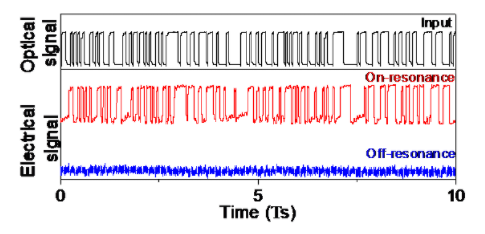Photolithographically fabricated silicon photonic crystal nanocavity photoreceiver with laterally integrated p-i-n diode
Research
Photolithographically fabricated silicon photonic crystal nanocavity photoreceiver with laterally integrated p-i-n diode
Towards compact monitoring device for optical network
Urgency of increased speed of data movement in very-short distance communication has become an attraction among researchers. With the development of technology, silicon photonic field have become one of its candidates. This is because photons do not produce Joule heating. In order to bridge the electrical circuits with photonic circuits, electro-optic and opto-electronic devices need to be developed. However, the realization of opto-electronic is challenging. This is because at telecom wavelength, silicon is transparent and photo carriers could not be generated. Therefore, germanium integration on silicon commonly has been preferable. But it requires complex fabrication method and reduce CMOS compatibility. Another approach that has been introduced is by ion-implantation techniques that is applicable to all-silicon opto-electronic detection. Still, this method is complex in fabrication and difficult to integrate with other CMOS devices. Furthermore, with the presence of defect, it increased the value of leak current.
Although recently low-power opto-electronic detection by all-silicon device in high Q PhC nanocavity has been reported, it has been demonstrated with an air-clad which requires a complex fabrication process. Therefore, in this study we demonstrated all-silicon photodetection using high Q PhC nanocavity cladded with SiO2 fabricated by photolithographic process. Two-photon absorption is used to detect light and we achieved low dark current (38 pA at -3V) due to the all-silicon made and SiO2 clad on the surface. Thanks to the low dark current, the minimum detectable optical power is -20 dBm. By the demonstration of sub-GHz dynamic response, this shows that the photoreceiver can be used as a wavelength-selective photoreceiver. With the small noise detection, low detectable power and small footprint (50μm2) make this device a good candidate as a cost-effective fiber monitoring system that is needed to ensure the quality service of optical networks.

Fig. 1 (a) Transmission spectrum and photocurrent at 10 μm input power as function of the input wavelength. (b, c) Transmission spectrum (b) and photocurrent (c) at various input powers when reverse -3 V is applied to the device

Fig. 2 0.1 Gb/s photoreceiver operation. The black waveform is the input optical signal, which is 255 pattern length of pseudorandom binary sequence. The red and blue waveforms is the output electrical signal at the resonance and 0.1nm detuned, respectively.
- カテゴリー
- 研究トピックス



